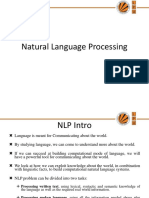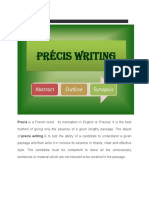An Introduction To Syntax
Uploaded by
krzysiekwieAn Introduction To Syntax
Uploaded by
krzysiekwieAn Introduction to Syntax
Syntax is a fundamental branch of linguistics and Natural Language Processing (NLP) that examines
the rules and principles governing the structure of sentences in a language. It focuses on how words
combine to form phrases, clauses, and sentences, ensuring meaningful communication. By analyzing
syntax, researchers and computational models can better understand how language operates at a
structural level, enabling applications like grammar checking, machine translation, and natural
language understanding.
The Basics of Syntax
Syntax defines the grammatical structure of a sentence, determining the correct order and relationship
between words. For instance, in English, the standard word order is Subject-Verb-Object (e.g., The cat
eats fish), while in languages like Japanese, it’s Subject-Object-Verb (e.g., Neko wa sakana o
tabemasu).
Key syntactic concepts include:
1. Parts of Speech: Words are categorized into classes like nouns, verbs, and adjectives based on
their syntactic roles.
2. Phrases: Groups of words that act as a single unit, such as noun phrases (the big house) or verb
phrases (is running quickly).
3. Sentence Structure: Sentences are composed of clauses, which can be independent (She ran
fast) or dependent (because she was late).
4. Grammatical Agreement: Syntax governs how elements like subject and verb must agree in
features like number or tense (e.g., He runs vs. They run).
Syntax in Computational Linguistics
In NLP, syntactic analysis enables computers to parse and understand sentence structures. Two main
approaches are:
• Constituency Parsing: Breaks sentences into nested tree structures, representing how phrases
combine. For example, the sentence The dog chased the ball would be divided into a noun
phrase (The dog) and a verb phrase (chased the ball).
• Dependency Parsing: Focuses on the relationships between words, identifying which word
governs another. For instance, in The dog chased the ball, chased is the root, while dog and ball
depend on it.
These techniques are essential for many NLP tasks, including machine translation, question answering,
and semantic analysis.
Syntax Challenges in Language Processing
1. Ambiguity: Many sentences have multiple syntactic interpretations. For instance, I saw the
man with a telescope could mean either that the man has a telescope or that the speaker used a
telescope to see the man.
2. Non-Standard Grammar: Informal language, such as text messages or social media posts,
often breaks traditional syntactic rules.
3. Cross-Linguistic Differences: Languages have diverse syntactic rules, making universal
parsing models challenging to develop.
4. Long-Range Dependencies: Sentences with complex structures, like embedded clauses, can be
difficult for computational systems to parse accurately.
Applications of Syntax
Understanding syntax is crucial for many practical applications:
• Grammar Checking: Tools like Grammarly rely on syntactic analysis to suggest corrections.
• Machine Translation: Accurate syntactic parsing ensures grammatically correct translations.
• Text Summarization: Identifying sentence structure helps algorithms extract key information.
• Dialogue Systems: Chatbots use syntax to interpret user input and generate coherent responses.
Future Directions
As NLP advances, researchers aim to integrate syntax with semantic understanding for more accurate
language processing. Hybrid models that combine syntactic parsing with neural networks are becoming
more common, allowing better handling of ambiguities and long-range dependencies. Additionally,
efforts to create syntactic parsers for low-resource languages continue to expand access to language
technology globally.
In conclusion, syntax is a cornerstone of linguistics and NLP, providing the framework for
understanding how language works structurally. Its study not only deepens our theoretical knowledge
of language but also enables a wide range of technologies that rely on accurate and fluent language
processing.
You might also like
- Short Stories in Korean For Intermediate Learners Intermediate Teach Yourself by Olly Richards100% (8)Short Stories in Korean For Intermediate Learners Intermediate Teach Yourself by Olly Richards253 pages
- English For Everyone Course Book Level 4 Advanced - Dorling Kindersley97% (39)English For Everyone Course Book Level 4 Advanced - Dorling Kindersley288 pages
- Atural Anguage Rocessing: Chandra Prakash LPUNo ratings yetAtural Anguage Rocessing: Chandra Prakash LPU59 pages
- (Makalah) Syntax and Sentence StructureNo ratings yet(Makalah) Syntax and Sentence Structure17 pages
- SYNTAX SYLLABUS Compiled and Edited by PDFNo ratings yetSYNTAX SYLLABUS Compiled and Edited by PDF43 pages
- Lecture 7. Syntax and Its Object of StudyNo ratings yetLecture 7. Syntax and Its Object of Study18 pages
- Unit V Intelligence and Applications: Morphological Analysis/Lexical AnalysisNo ratings yetUnit V Intelligence and Applications: Morphological Analysis/Lexical Analysis30 pages
- English Grammar Made Easy: How to Understand English Grammar as a BeginnerFrom EverandEnglish Grammar Made Easy: How to Understand English Grammar as a Beginner5/5 (1)
- Introduction To Natural Language ProcessingNo ratings yetIntroduction To Natural Language Processing45 pages
- ACFrOgBKMtkrKQXYgwzYfGAQxQ0GJjQ4MloahBs6vi5pwqo xRZUN6IRgh8lAAyR2U7sguAn6becvxh174Y RYo84nZ3K9mm OlN3Q JrDvd18FxMzMkCBuxruzd1tH0C6XqndKXsCSXuwHIWVT7olg5FKOstIhFYq-Kh6hMBgNo ratings yetACFrOgBKMtkrKQXYgwzYfGAQxQ0GJjQ4MloahBs6vi5pwqo xRZUN6IRgh8lAAyR2U7sguAn6becvxh174Y RYo84nZ3K9mm OlN3Q JrDvd18FxMzMkCBuxruzd1tH0C6XqndKXsCSXuwHIWVT7olg5FKOstIhFYq-Kh6hMBg32 pages
- Natural Language Processing by DR A NageshNo ratings yetNatural Language Processing by DR A Nagesh136 pages
- Year 3 Unit 1: Welcome Topic: Let'S Play - Tell Me The Time Content Standard Learning Standard Activities Teacher Assessment Rubic Task 1No ratings yetYear 3 Unit 1: Welcome Topic: Let'S Play - Tell Me The Time Content Standard Learning Standard Activities Teacher Assessment Rubic Task 17 pages
- Presentation On Technical Report WritingNo ratings yetPresentation On Technical Report Writing20 pages
- Celpip Task 8: Describing An Unusual SituationNo ratings yetCelpip Task 8: Describing An Unusual Situation10 pages
- Natural Language Processing Module1(CH-1)No ratings yetNatural Language Processing Module1(CH-1)11 pages
- Phrasal Verbs - Chapter Wise PDF (English)No ratings yetPhrasal Verbs - Chapter Wise PDF (English)24 pages
- Scheme of Work English For Communication Form 1 Special EducationNo ratings yetScheme of Work English For Communication Form 1 Special Education4 pages
- Full Download Korean Morphosyntax Focusing On Clitics and Their Roles in Syntax 1st Edition Hee-Rahk Chae PDF100% (5)Full Download Korean Morphosyntax Focusing On Clitics and Their Roles in Syntax 1st Edition Hee-Rahk Chae PDF55 pages
- Participle Phrases As Reduced A RelativesNo ratings yetParticiple Phrases As Reduced A Relatives4 pages

























































































